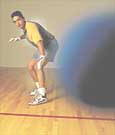
|
|
|
|
|
|
|
|
Have some fun with this list taken from: Handball Basics George Zafferano Sterling Publishing 1977. Using a scale of 0 to 5 points, rate yourself against the 25 mistakes listed in this Checklist. If you commit a mistake frequently give yourself zero. Thats right you gotta be brutally honest!! Occasionally is worth three points and rarely is worth five points. BE SINCERE and self critical! Reevaluate yourself every few weeks to see if your total increases.
SKILLS EVALUATION CHECKLIST: |
|

|
Off the Wall Handball is the ideal indoor game to keep you fit, fast and fat-free. Originally featured in: Men's Fitness January, 2001 Written by: Bob Cooper Photos by: Dave Nagel Freelance writer Bob Cooper is a frequent contributor to Men's Fitness. |
|
The whoosh of the heavy doors of the Olympic Club quickly seals out the San Francisco street
clamor. The quiet lobby, so noise-free you can hear a glove plop on the floor, signals it's Friday
night, a time when most members of the downtown athletic club have better things to do than
work out. But not everyone. In a corner of the top floor, four hale guys are swatting a two-inch-diameter blue ball as if it
were a fly buzzing around their beer. The action is fast and furious. The foursome, who range in age from 24 to 45, burst around the 20- by 40-foot court-forward, backward, laterally, occasionally diving headlong for the ball,
which ricochets off the four walls at a blistering 70 miles per.
More tactical than racquetball, which is played on the same courts, faster than tennis, and demanding more precision and stamina than any racquet sport, handball is the ultimate court game. Many who try it just once throw their bruised hands up in frustration, but most who stick with it a while become permanent converts. And it burns fat tissue better than a spa weekend in the second ring of hell. "Handball has a long learning curve," says Bernie Samet, the Olympic's handball and squash director, as he watches each lunge with clinical detachment. "Learning to anticipate where the ball will end up isn't easy. Timing and technique are everything. But handball gets in your blood. The great thing about my job is that when three players need a fourth, I'm always around. They ask me, and it's like putting heroin in front of an addict."
The Benefits While the benefits of handball are many, the risks are few. "It's a relatively injury-free sport," says Dr. John Aronen, U.S. Handball's sports-medicine consultant. "Most injuries that do occur are muscle strains in the shoulder, elbow and back, but those are avoidable if you follow a basic conditioning, strengthening and stretching program." Impact injuries are surprisingly rare, although overexuberant players have been known to dislocate fingers charging into side walls. The most unique aspect of the sport is summarized by the bumper sticker "Handball Players Do It With Both Hands." Developing coordination and power in your non-dominant, or "off," hand takes time, but if you don't become semi-ambidextrous, your opponent is certain to exploit your weak side. This is the hardest part of handball to pick up, but also what sets it apart; every other sport neglects your weak arm. Accuracy is also crucial. Martin compares handball to golf. "Both are extremely challenging to play well," she notes, "because they involve striking a small ball with a great deal of precision. The additional challenge of handball is that the ball is moving when you hit it." Also like golf, taking your eye off the ball may be the most common beginner's error.
The History
The Rules
The Technique Different strokes: The sidearm is your power stroke and is similar to skipping a rock on a pond. Crouch low to make either of these rally-ending sidearm shots: a "kill shot" (a line drive so low to the floor that your opponent can't get to it before it bounces twice) or a "passing shot" (placing the ball out of an opponent's reach). The other most common shot is the "overhand," which is comparable to pitching a baseball. It's primarily a defensive shot, however, because it usually keeps the ball bouncing high and slow, instead of low and fast. Footwork: Without the benefit of a racquet's reach, you'll need to run to the ball more than you do in racquet sports. Try to get to a position two steps behind the point where you expect to strike the ball. This will let you adjust for miscalculations and step into the shot. Also, like a tennis player, edge forward the moment your opponent is serving to be ready to spring toward the ball.
The Essentials The Competitive Sport As the leading pro, Chapman pockets about $35,000 a year, less than he earns from his "real job" at an auto dealership. It ain't no glamour sport, but there's an age group for everyone, including handball aficionados Bill Cosby and Ed Married...With Children O'Neill. The Web site of U.S. Handball (520-795-0434), www.www.ushandball.org, contains rules, instructional articles and links, along with directories of clubs, players and tournaments. There are about 40,000 regular four-wall players in the U.S., and a smaller number who play one of the outdoor-handball variations: one-wall, which is big in New York City, and three-wall, popular in California and Florida. Four-wall handball's major advantage is that it can be played on any racquetball court. There are 3,000 of those, most at racquet and health clubs, YMCAs and universities.
The Brotherhood |
|

